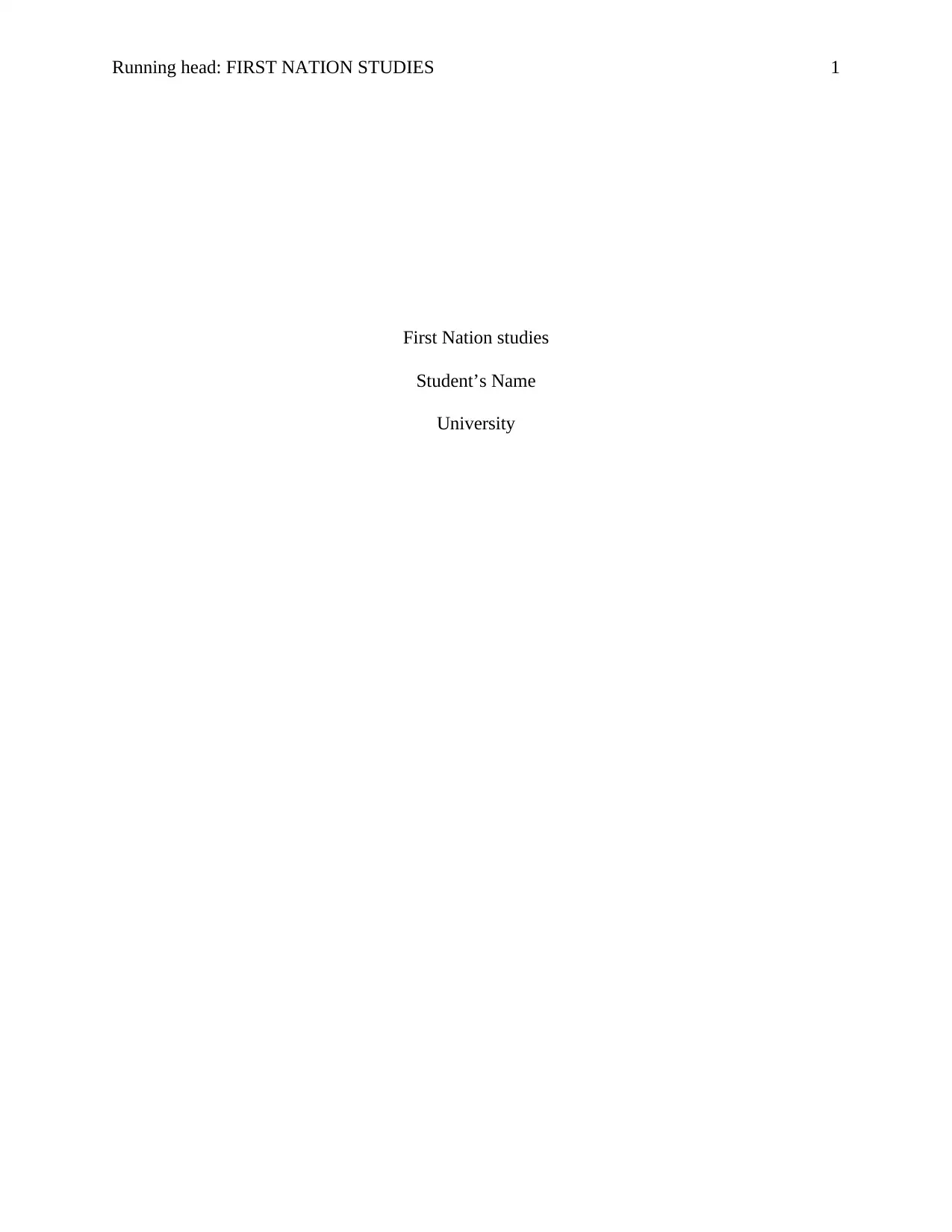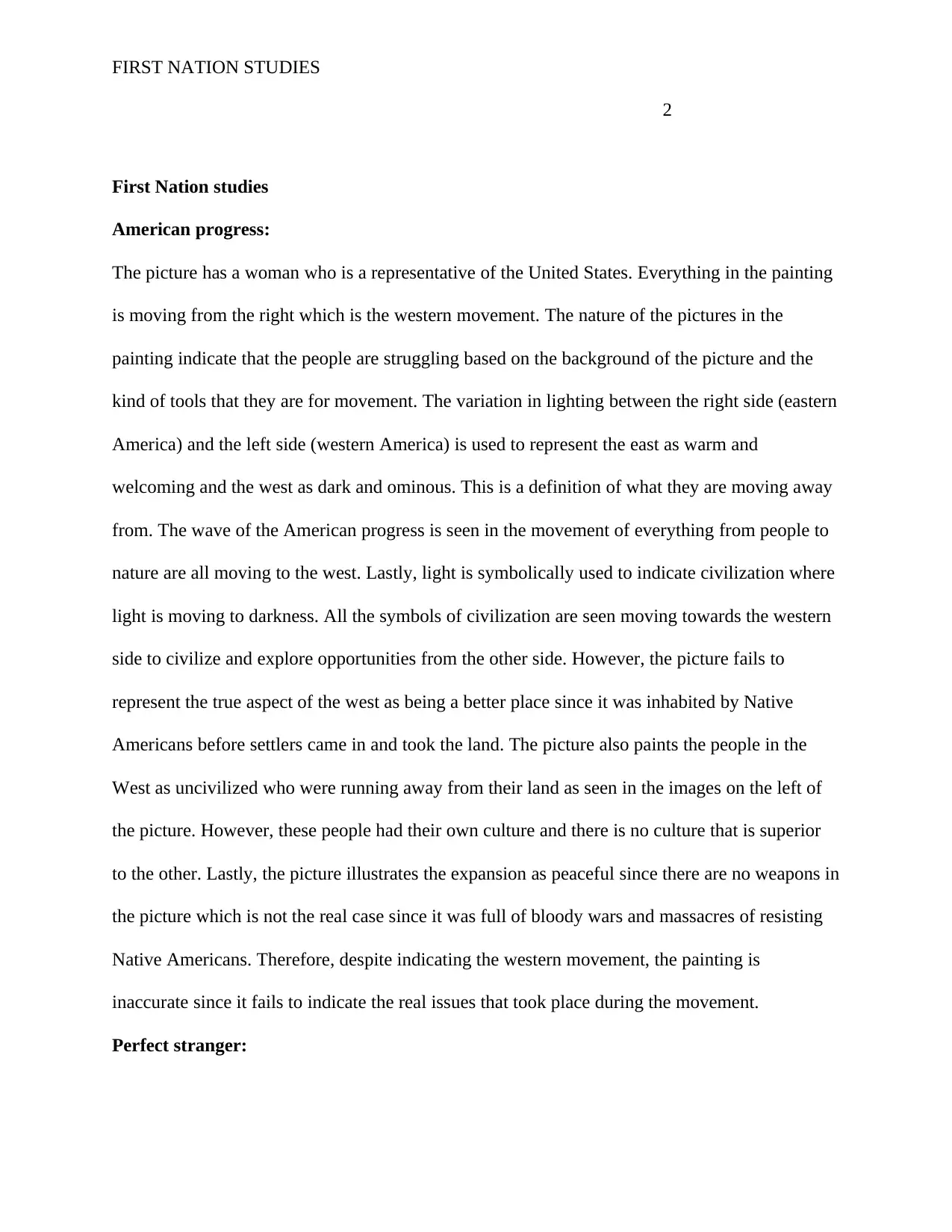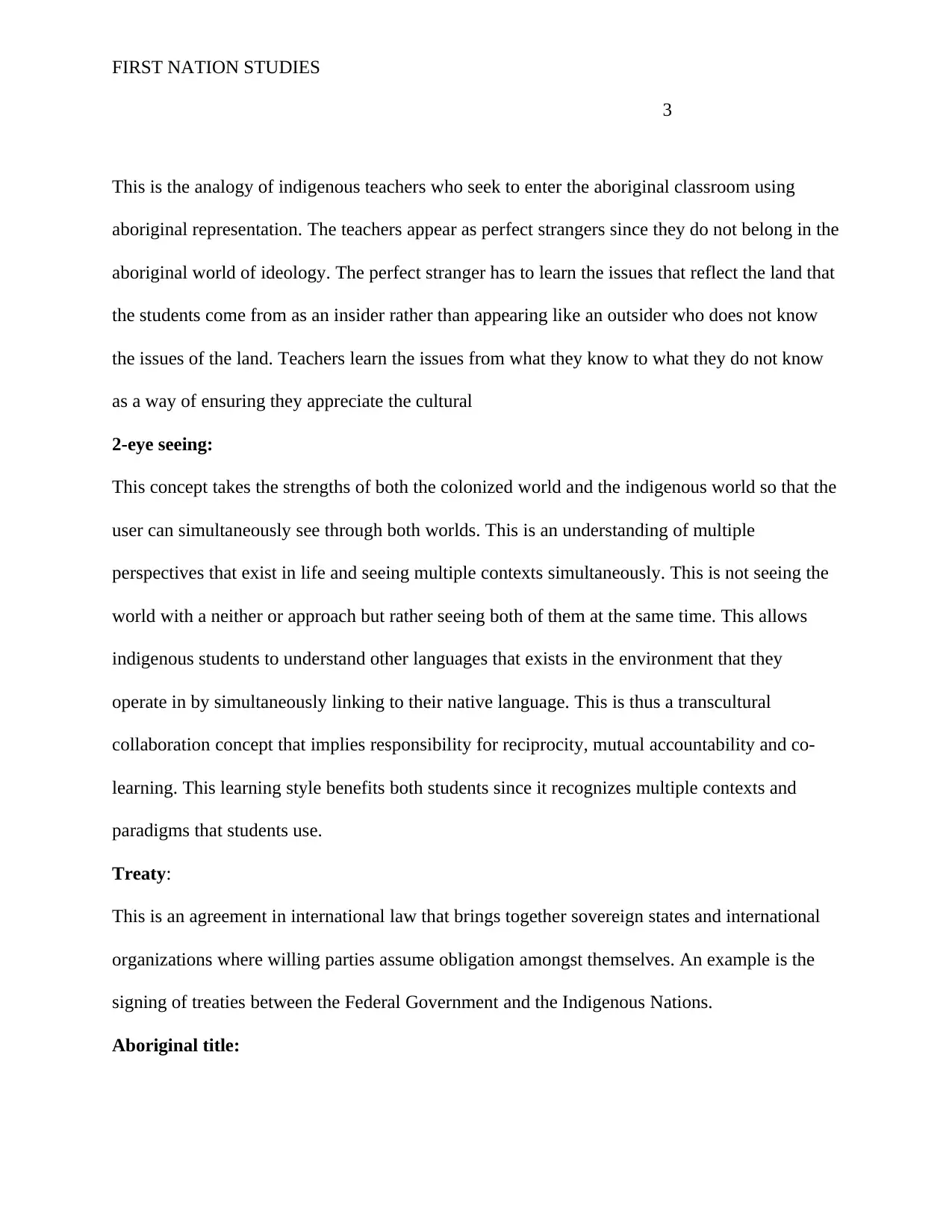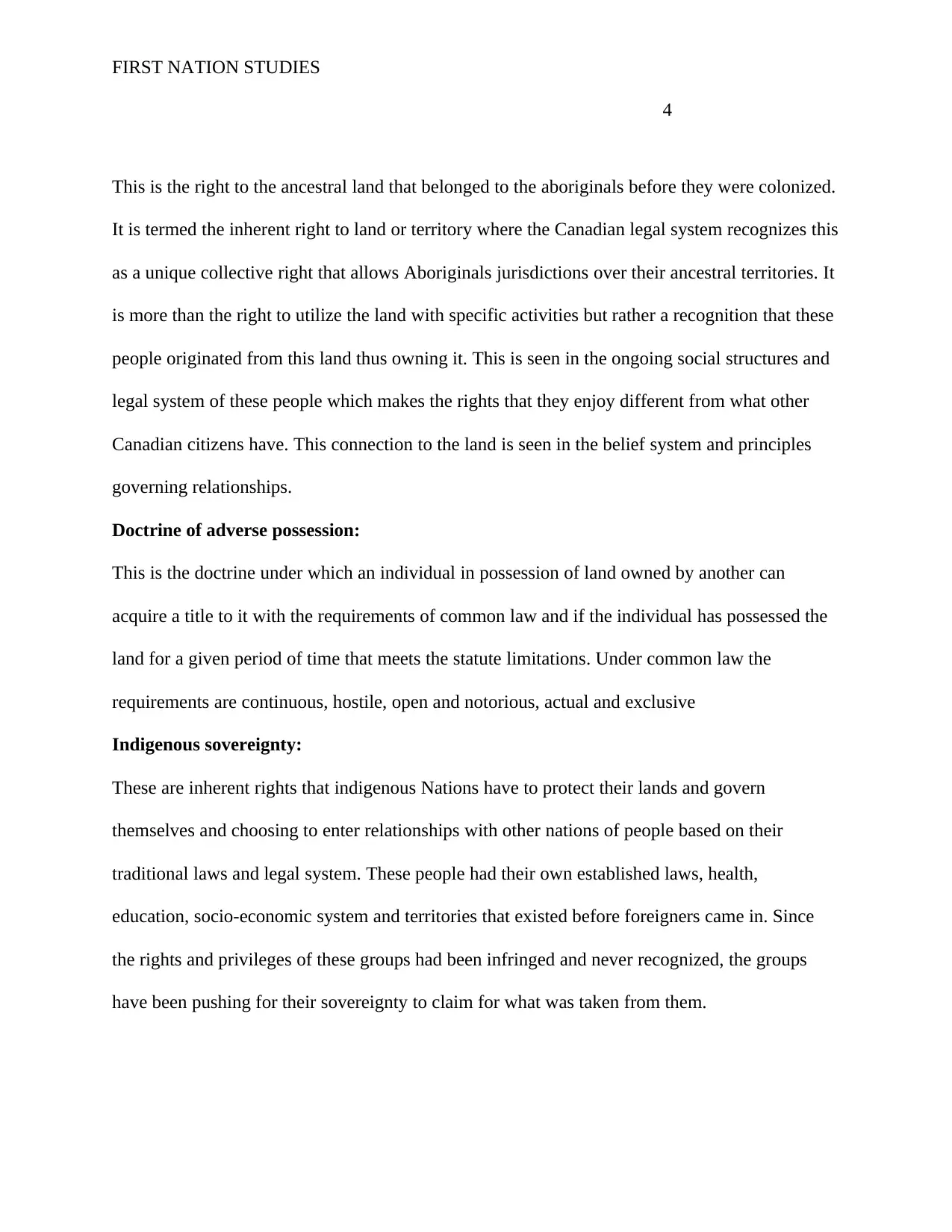FNST 101-3: Diversities, Land, Belonging, Justice & First Nations
VerifiedAdded on 2023/06/11
|4
|906
|198
Essay
AI Summary
This essay delves into key concepts within First Nation studies, providing explanations and analyses of terms such as "American progress" and its misrepresentation of westward expansion, the analogy of indigenous teachers as "perfect strangers," the concept of "2-eye seeing" as a transcultural collaboration, the definition and implications of "treaty" and "Aboriginal title," the "doctrine of adverse possession," and the importance of "Indigenous sovereignty." It highlights the inaccuracies in historical representations and emphasizes the need for understanding multiple perspectives and recognizing Indigenous rights and governance. The essay also references FNST 101 course material, including codes of conduct emphasizing respect, teamwork, and ethical behavior.

Running head: FIRST NATION STUDIES 1
First Nation studies
Student’s Name
University
First Nation studies
Student’s Name
University
Paraphrase This Document
Need a fresh take? Get an instant paraphrase of this document with our AI Paraphraser

FIRST NATION STUDIES
2
First Nation studies
American progress:
The picture has a woman who is a representative of the United States. Everything in the painting
is moving from the right which is the western movement. The nature of the pictures in the
painting indicate that the people are struggling based on the background of the picture and the
kind of tools that they are for movement. The variation in lighting between the right side (eastern
America) and the left side (western America) is used to represent the east as warm and
welcoming and the west as dark and ominous. This is a definition of what they are moving away
from. The wave of the American progress is seen in the movement of everything from people to
nature are all moving to the west. Lastly, light is symbolically used to indicate civilization where
light is moving to darkness. All the symbols of civilization are seen moving towards the western
side to civilize and explore opportunities from the other side. However, the picture fails to
represent the true aspect of the west as being a better place since it was inhabited by Native
Americans before settlers came in and took the land. The picture also paints the people in the
West as uncivilized who were running away from their land as seen in the images on the left of
the picture. However, these people had their own culture and there is no culture that is superior
to the other. Lastly, the picture illustrates the expansion as peaceful since there are no weapons in
the picture which is not the real case since it was full of bloody wars and massacres of resisting
Native Americans. Therefore, despite indicating the western movement, the painting is
inaccurate since it fails to indicate the real issues that took place during the movement.
Perfect stranger:
2
First Nation studies
American progress:
The picture has a woman who is a representative of the United States. Everything in the painting
is moving from the right which is the western movement. The nature of the pictures in the
painting indicate that the people are struggling based on the background of the picture and the
kind of tools that they are for movement. The variation in lighting between the right side (eastern
America) and the left side (western America) is used to represent the east as warm and
welcoming and the west as dark and ominous. This is a definition of what they are moving away
from. The wave of the American progress is seen in the movement of everything from people to
nature are all moving to the west. Lastly, light is symbolically used to indicate civilization where
light is moving to darkness. All the symbols of civilization are seen moving towards the western
side to civilize and explore opportunities from the other side. However, the picture fails to
represent the true aspect of the west as being a better place since it was inhabited by Native
Americans before settlers came in and took the land. The picture also paints the people in the
West as uncivilized who were running away from their land as seen in the images on the left of
the picture. However, these people had their own culture and there is no culture that is superior
to the other. Lastly, the picture illustrates the expansion as peaceful since there are no weapons in
the picture which is not the real case since it was full of bloody wars and massacres of resisting
Native Americans. Therefore, despite indicating the western movement, the painting is
inaccurate since it fails to indicate the real issues that took place during the movement.
Perfect stranger:

FIRST NATION STUDIES
3
This is the analogy of indigenous teachers who seek to enter the aboriginal classroom using
aboriginal representation. The teachers appear as perfect strangers since they do not belong in the
aboriginal world of ideology. The perfect stranger has to learn the issues that reflect the land that
the students come from as an insider rather than appearing like an outsider who does not know
the issues of the land. Teachers learn the issues from what they know to what they do not know
as a way of ensuring they appreciate the cultural
2-eye seeing:
This concept takes the strengths of both the colonized world and the indigenous world so that the
user can simultaneously see through both worlds. This is an understanding of multiple
perspectives that exist in life and seeing multiple contexts simultaneously. This is not seeing the
world with a neither or approach but rather seeing both of them at the same time. This allows
indigenous students to understand other languages that exists in the environment that they
operate in by simultaneously linking to their native language. This is thus a transcultural
collaboration concept that implies responsibility for reciprocity, mutual accountability and co-
learning. This learning style benefits both students since it recognizes multiple contexts and
paradigms that students use.
Treaty:
This is an agreement in international law that brings together sovereign states and international
organizations where willing parties assume obligation amongst themselves. An example is the
signing of treaties between the Federal Government and the Indigenous Nations.
Aboriginal title:
3
This is the analogy of indigenous teachers who seek to enter the aboriginal classroom using
aboriginal representation. The teachers appear as perfect strangers since they do not belong in the
aboriginal world of ideology. The perfect stranger has to learn the issues that reflect the land that
the students come from as an insider rather than appearing like an outsider who does not know
the issues of the land. Teachers learn the issues from what they know to what they do not know
as a way of ensuring they appreciate the cultural
2-eye seeing:
This concept takes the strengths of both the colonized world and the indigenous world so that the
user can simultaneously see through both worlds. This is an understanding of multiple
perspectives that exist in life and seeing multiple contexts simultaneously. This is not seeing the
world with a neither or approach but rather seeing both of them at the same time. This allows
indigenous students to understand other languages that exists in the environment that they
operate in by simultaneously linking to their native language. This is thus a transcultural
collaboration concept that implies responsibility for reciprocity, mutual accountability and co-
learning. This learning style benefits both students since it recognizes multiple contexts and
paradigms that students use.
Treaty:
This is an agreement in international law that brings together sovereign states and international
organizations where willing parties assume obligation amongst themselves. An example is the
signing of treaties between the Federal Government and the Indigenous Nations.
Aboriginal title:
⊘ This is a preview!⊘
Do you want full access?
Subscribe today to unlock all pages.

Trusted by 1+ million students worldwide

FIRST NATION STUDIES
4
This is the right to the ancestral land that belonged to the aboriginals before they were colonized.
It is termed the inherent right to land or territory where the Canadian legal system recognizes this
as a unique collective right that allows Aboriginals jurisdictions over their ancestral territories. It
is more than the right to utilize the land with specific activities but rather a recognition that these
people originated from this land thus owning it. This is seen in the ongoing social structures and
legal system of these people which makes the rights that they enjoy different from what other
Canadian citizens have. This connection to the land is seen in the belief system and principles
governing relationships.
Doctrine of adverse possession:
This is the doctrine under which an individual in possession of land owned by another can
acquire a title to it with the requirements of common law and if the individual has possessed the
land for a given period of time that meets the statute limitations. Under common law the
requirements are continuous, hostile, open and notorious, actual and exclusive
Indigenous sovereignty:
These are inherent rights that indigenous Nations have to protect their lands and govern
themselves and choosing to enter relationships with other nations of people based on their
traditional laws and legal system. These people had their own established laws, health,
education, socio-economic system and territories that existed before foreigners came in. Since
the rights and privileges of these groups had been infringed and never recognized, the groups
have been pushing for their sovereignty to claim for what was taken from them.
4
This is the right to the ancestral land that belonged to the aboriginals before they were colonized.
It is termed the inherent right to land or territory where the Canadian legal system recognizes this
as a unique collective right that allows Aboriginals jurisdictions over their ancestral territories. It
is more than the right to utilize the land with specific activities but rather a recognition that these
people originated from this land thus owning it. This is seen in the ongoing social structures and
legal system of these people which makes the rights that they enjoy different from what other
Canadian citizens have. This connection to the land is seen in the belief system and principles
governing relationships.
Doctrine of adverse possession:
This is the doctrine under which an individual in possession of land owned by another can
acquire a title to it with the requirements of common law and if the individual has possessed the
land for a given period of time that meets the statute limitations. Under common law the
requirements are continuous, hostile, open and notorious, actual and exclusive
Indigenous sovereignty:
These are inherent rights that indigenous Nations have to protect their lands and govern
themselves and choosing to enter relationships with other nations of people based on their
traditional laws and legal system. These people had their own established laws, health,
education, socio-economic system and territories that existed before foreigners came in. Since
the rights and privileges of these groups had been infringed and never recognized, the groups
have been pushing for their sovereignty to claim for what was taken from them.
1 out of 4
Your All-in-One AI-Powered Toolkit for Academic Success.
+13062052269
info@desklib.com
Available 24*7 on WhatsApp / Email
![[object Object]](/_next/static/media/star-bottom.7253800d.svg)
Unlock your academic potential
Copyright © 2020–2025 A2Z Services. All Rights Reserved. Developed and managed by ZUCOL.